Mitochondria and Emotional Energy: The Cellular Power Behind Your Mood
Introduction
When your energy is low, everything feels harder. You’re less patient, less motivated, and even small stressors feel overwhelming. But what if that “emotional fatigue” isn’t just in your head — what if it’s in your cells?
Deep inside every cell of your body live tiny power generators called mitochondria. They convert the food you eat and the oxygen you breathe into the energy that fuels every thought, movement, and emotion.
When your mitochondria thrive, you feel clear, calm, and capable. When they struggle, fatigue, irritability, and emotional flatness take over.
Recent research reveals that mitochondrial health isn’t just about physical stamina — it’s the foundation of emotional resilience. 🧠💫
Let’s explore how these microscopic engines influence mood, how stress and inflammation deplete them, and how you can recharge your emotional energy from the inside out. 🌞
Looking for supplements for Emotional Energy? Click here.
🔋 What Are Mitochondria?
Mitochondria are often called the “powerhouses of the cell.” They take nutrients (like glucose and fatty acids) and turn them into ATP (adenosine triphosphate) — the molecule your body uses for energy.
But beyond energy, mitochondria play crucial roles in:
Hormone production (including stress hormones and sex hormones)
Neurotransmitter regulation (serotonin, dopamine, and GABA)
Inflammation control
Cell repair and apoptosis (healthy renewal)
Brain plasticity and emotional balance
In short, mitochondria don’t just power your body — they govern your emotional stability and motivation too. 🌿
🧠 Mitochondria and the Emotional Brain

Your brain is one of the most energy-demanding organs in your body. Despite weighing only about 2% of your total mass, it uses around 20–25% of your energy supply.
That energy comes directly from mitochondrial activity inside neurons.
When your mitochondria are functioning well, neurons fire efficiently, neurotransmitters balance smoothly, and the brain’s emotional circuits stay stable.
When mitochondrial output declines, the brain’s communication system falters — leading to mood instability, brain fog, and emotional fatigue.
🪫 Think of it like Wi-Fi for emotions: when your mitochondria lag, your emotional signal weakens.
🌊 The Mitochondrial–Mood Connection
Energy and Motivation (Dopamine)
Dopamine, the neurotransmitter linked to motivation and reward, is produced and recycled through energy-intensive processes.
If mitochondria can’t generate enough ATP, dopamine signaling slows — leaving you feeling unmotivated or detached.
💬 “I want to do things, but I just can’t seem to start.”
That’s often a mitochondrial problem masquerading as apathy.
Stress Response (Cortisol and HPA Axis)
When you experience stress, your mitochondria help power the HPA axis (Hypothalamic–Pituitary–Adrenal system).
Healthy mitochondria regulate cortisol release — helping you recover from stress faster.
But under chronic stress, mitochondria become damaged by oxidative overload, causing fatigue and emotional burnout.
⚖️ Balanced mitochondria = calm recovery.
Overloaded mitochondria = exhaustion and irritability.
Resilience and Emotional Adaptation
Resilience — your ability to bounce back — depends on neuroplasticity, the brain’s capacity to form new connections.
Mitochondria supply the energy needed for these changes. Without it, learning, therapy, and emotional regulation feel harder.
🧬 Every act of emotional healing requires mitochondrial energy.
🔥 The Mitochondrial Stress Cycle
Modern life puts mitochondria under constant pressure. Stress hormones, toxins, and poor nutrition all increase oxidative stress — a buildup of damaging free radicals that impair mitochondrial function.
The Cycle Looks Like This:
Stress → cortisol and adrenaline surge.
Mitochondria work overtime → generate more free radicals.
Antioxidant defenses become depleted.
Mitochondria become damaged → produce less energy.
You feel drained → stress tolerance drops further.
This creates a vicious loop of exhaustion and emotional instability.
“Mitochondrial dysfunction is to fatigue what emotional overload is to burnout.” 🌿
🌫️ Signs Your Mitochondria Might Be Fatigued
Chronic tiredness or “wired but tired” feeling ⚡
Emotional volatility or irritability 😣
Low motivation or brain fog 💭
Sensitivity to stress or noise 🔊
Muscle weakness or slow recovery after exercise 🏋️
Sleep disruptions 😴
Cold hands or low body temperature ❄️
These aren’t just signs of “stress” — they’re energy communication breakdowns between your cells and your brain.
🌿 How Mitochondrial Health Shapes Emotional Resilience
Regulating Cortisol and Adrenal Function
Healthy mitochondria ensure a smooth rise and fall of cortisol — your stress hormone.
When they falter, cortisol remains elevated, making you feel anxious or tense. Over time, cortisol may drop too low (adrenal fatigue), leaving you exhausted and numb.
Mitochondria are like the thermostat for your stress response. 🌡️
Supporting Serotonin and GABA
Serotonin (calm and contentment) and GABA (relaxation) depend on mitochondrial enzymes for synthesis.
When energy is low, these neurotransmitters decline, leading to anxiety, sadness, or sleep troubles.
💤 Your calm chemistry requires clean, powerful energy.
Balancing Inflammation
Mitochondria regulate inflammation by controlling how immune cells respond to stress.
When they’re healthy, inflammation rises and falls naturally. When they’re dysfunctional, inflammation lingers — clouding mood and cognition.
That’s why mitochondrial repair is at the center of anti-inflammatory and emotional wellness strategies alike. 🌸
🥦 Nutrition for Mitochondrial and Emotional Energy
The right foods can dramatically improve mitochondrial performance. Here’s what to focus on:
🍳 Healthy Fats for Membrane Integrity
Mitochondria have delicate membranes that need omega-3 fatty acids and phospholipids to function.
Eat: salmon, sardines, flaxseed, eggs, avocado, olive oil.
🥬 Antioxidants to Reduce Damage
Antioxidants protect mitochondria from oxidative stress caused by toxins, pollution, and stress.
Eat: berries, dark chocolate, turmeric, leafy greens, green tea.
🥩 Amino Acids for Repair
Protein provides building blocks for enzymes that fuel mitochondria.
Eat: eggs, fish, legumes, and bone broth.
🍠 Complex Carbs for Steady Energy
Your brain runs on glucose, but it needs a steady, clean supply.
Eat: oats, quinoa, sweet potatoes, lentils.
🌿 Micronutrients for Power Conversion
Mitochondria rely on minerals and vitamins to convert food into ATP.
Magnesium – energy metabolism
B Vitamins (B1, B2, B3, B6, B12) – coenzymes for ATP production
Iron – oxygen transport
CoQ10 – critical for electron transport
💊 Supplements to Support Mitochondrial Function
| Supplement | Role | Emotional Benefit |
|---|---|---|
| CoQ10 (Ubiquinol) | Powers mitochondrial ATP production | Increases motivation, reduces fatigue |
| PQQ (Pyrroloquinoline Quinone) | Stimulates new mitochondria growth | Enhances mental clarity and mood |
| Acetyl-L-Carnitine (ALCAR) | Transports fatty acids into mitochondria | Boosts focus and emotional resilience |
| Alpha-Lipoic Acid (ALA) | Antioxidant that regenerates others | Reduces brain fog and irritability |
| Magnesium Glycinate | Calms HPA axis and muscles | Lowers anxiety and improves sleep |
| N-Acetyl Cysteine (NAC) | Builds glutathione, repairs oxidative damage | Supports emotional recovery |
🧠 These compounds turn cellular repair into emotional renewal.
Looking for supplements for Emotional Energy? Click here.
💞 Mitochondria, Emotions, and the Gut-Brain Axis
The mitochondria in your gut cells affect the balance of bacteria that produce serotonin, dopamine, and GABA.
Chronic gut inflammation → mitochondrial damage → mood dysregulation.
To restore emotional energy:
Eat fiber-rich foods for healthy microbiota.
Avoid processed sugars and oils that inflame the gut.
Use probiotics or fermented foods (kimchi, kefir, yogurt).
🦠 Your gut’s mitochondria whisper to your brain: “You’re safe.”
🌬️ Breathwork and Oxygenation

Mitochondria depend on oxygen. Shallow breathing (common during stress) limits oxygen flow, reducing ATP production.
Breathwork restores this flow and signals safety to the nervous system.
Try:
4-6 breathing — inhale 4 seconds, exhale 6 seconds.
Practice for 5–10 minutes to boost oxygen, calm cortisol, and feed your cells. 🌬️
Want to try Breathwork? Click Here.
💪 Exercise: The Ultimate Mitochondrial Tonic
Exercise is one of the most powerful mitochondrial boosters known.
Moderate aerobic activity increases both the number and efficiency of mitochondria (a process called mitochondrial biogenesis).
Best Activities for Emotional Energy
Brisk walking or cycling 🚴
Yoga and Tai Chi 🧘
Strength training 🏋️
Dancing or movement meditation 💃
⚡ Every movement is a signal to your cells: “Make more energy — I’m alive.”
💤 Sleep: Where Mitochondria Recharge
Mitochondrial repair happens primarily during deep sleep.
When sleep is poor:
ATP production drops.
Reactive oxygen species (ROS) accumulate.
Emotional regulation declines.
Tips for mitochondrial sleep hygiene:
Sleep 7–9 hours consistently.
Keep the room cool (18–20°C / 65–68°F).
Limit blue light before bed.
Magnesium or reishi tea can support deeper rest. 🌙
🪷 Sleep is the lab where emotional energy is rebuilt.
🧘 Emotional Practices That Heal Mitochondria
Your emotional patterns can directly affect cellular health. Stress, resentment, and chronic worry activate the sympathetic nervous system, flooding cells with damaging chemicals.
Mind–body practices literally calm your mitochondria.
💨 Meditation
Reduces oxidative stress, boosts ATP efficiency, and enhances prefrontal regulation.
🌿 Gratitude and Compassion
Lower inflammatory cytokines, allowing mitochondria to restore balance.
💞 Emotional Release
Crying, journaling, or therapy free the nervous system from chronic tension — oxygen and energy flow improve immediately.
“When you release emotional tension, you free your mitochondria from survival mode.”
🧬 Trauma, Stress, and Mitochondrial Memory
Research shows that mitochondria can even store “stress memories.”
Prolonged trauma alters mitochondrial DNA and energy output, making stress responses hypersensitive.
But neuroplasticity and lifestyle change can reverse these patterns.
Practices like somatic therapy, cold exposure, and mindful movement train both brain and mitochondria to interpret stress as challenge, not threat.
🧠 Healing trauma restores your cellular sense of safety.
Looking for online therapy ? Click Here.
🌻 The Mitochondrial–Inflammation Loop
Damaged mitochondria leak free radicals that trigger inflammation — which in turn damages mitochondria further.
Breaking this loop is essential for mood recovery.
How to do it:
Eat anti-inflammatory foods (omega-3s, turmeric, greens).
Sleep deeply.
Practice stress reduction daily.
Support mitochondrial repair with antioxidants.
Once inflammation drops, mitochondrial energy — and emotional resilience — rebound. 🌿
🌞 Morning-to-Night Mitochondrial Routine
🌤️ Morning
Hydrate with lemon water.
Step into natural sunlight for circadian alignment.
Eat protein and healthy fats for clean energy.
☀️ Afternoon
Take a walk or stretch break.
Eat antioxidant-rich snacks (berries, nuts).
Practice a short breathing reset.
🌙 Evening
Avoid screens and caffeine 2 hours before bed.
Take magnesium or CoQ10 if supplementing.
Reflect on gratitude to lower oxidative load.
🌱 Daily rhythm = mitochondrial rhythm = emotional rhythm.
💫 The Spiritual Side of Cellular Energy
In many traditions, “life energy” or qi mirrors what science now calls ATP — a flow that powers body, mind, and spirit.
When mitochondria are balanced, you don’t just feel energized — you feel alive, present, and connected.
When depleted, even positive moments feel muted.
Recharging your mitochondria is an act of emotional and spiritual renewal — a return to vitality at every level. 🌸
🌿 Final Thoughts: Powering the Mind from the Inside Out
Your emotions are not separate from your biology — they’re powered by it.
When your mitochondria hum with energy, your brain communicates clearly, your mood stabilizes, and your resilience expands.
Caring for these tiny powerhouses means eating whole foods, sleeping deeply, breathing consciously, and practicing emotional regulation.
“Every calm breath, every nutrient-rich meal, every night of deep rest is a spark of new energy — not just for your body, but for your soul.” 🌞
Mitochondria are the silent engines of emotional strength. When you nourish them, you recharge the essence of life itself.
📚 References
Picard, M., & McEwen, B. S. (2018). Psychological stress and mitochondria: A conceptual framework. Psychosomatic Medicine.
Manji, H. K. et al. (2012). Mitochondrial dysfunction in mood disorders: The evidence and therapeutic implications. Molecular Psychiatry.
Wang, Y. et al. (2019). Mitochondrial function and oxidative stress in anxiety and depression. Journal of Affective Disorders.
Wallace, D. C. (2015). Mitochondrial bioenergetics in human evolution and disease. Nature.
Martin, W. F. (2020). Mitochondrial origins and physiology. Annual Review of Microbiology.
Karabatsiakis, A. et al. (2014). Mitochondrial alterations after childhood trauma. Translational Psychiatry.
Nicolson, G. L. (2014). Mitochondrial dysfunction and chronic fatigue. Integrative Medicine.
Anderson, G., & Maes, M. (2014). Mitochondrial dysfunction in depression and bipolar disorder. CNS & Neurological Disorders.
Tyrrell, D. J. et al. (2020). Exercise and mitochondrial resilience: A mechanism for mental health. Frontiers in Physiology.
Polizzi, C. et al. (2021). Nutritional modulation of mitochondria and mood. Nutrients.
Related Posts
-
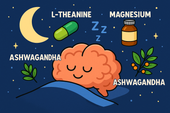
Nootropics That Promote Calm and Rest
Explore the world of calming nootropics — natural brain enhancers that promote relaxation, better focus, and deeper rest. Learn how L-Theanine, magnesium, ashwagandha, and other adaptogens help balance your nervous system, reduce stress, and support restorative sleep.
-

Best Natural Supplement Stack for Sleep
Discover the best natural supplement stack for deep, restorative sleep. Learn how nutrients like magnesium, L-theanine, glycine, and calming herbs such as chamomile and ashwagandha work together to relax your body, calm your mind, and improve sleep quality—naturally and safely.
-
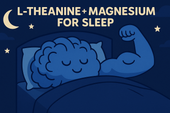
Combining L-Theanine and Magnesium for Sleep: A Calm Night, Naturally
Discover how combining L-Theanine and Magnesium can help you drift into deep, restorative sleep. Learn how this natural duo calms the mind, relaxes the body, and supports your nervous system—without grogginess the next morning.
-

How to Sleep Better After Intense Workouts
Struggling to fall asleep after a tough workout? Learn how to optimize your post-training recovery with nutrition, hydration, and science-backed sleep strategies. Discover how to calm your nervous system, balance hormones, and wake up fully recharged for your next session.
-

Ashwagandha and Valerian: A Bedtime Combo for Deep Rest and Emotional Reset
Discover the calming synergy of Ashwagandha and Valerian root, two natural sleep aids that help quiet the mind, ease anxiety, and promote deeper rest. Learn how this herbal duo supports the nervous system, balances stress hormones, and restores emotional peace — without next-day grogginess.
-

How to Create a Resilience-Boosting Diet
Discover how to build emotional and physical strength from the inside out with a resilience-boosting diet 🍎. Learn which foods stabilize your mood, how supplements like magnesium and omega-3s strengthen your stress response, and why pairing nutrition with breathwork and therapy creates lasting calm, focus, and vitality 🌿💪.
-

Best Teas and Herbal Blends for Calmness: Nature’s Way to Restore Inner Peace
Ashwagandha, the ancient adaptogenic herb, helps your body find balance during stress. Known as “Indian ginseng,” it supports cortisol regulation, boosts energy, and restores calm clarity. Discover how this powerful root promotes resilience, emotional balance, and steady vitality — one cup at a time. 🌸
-

Parenting and Emotional Strength: How to Raise Children Without Losing Yourself
Empathy is the bridge that connects hearts — the quiet power to understand, feel, and support another’s emotions without judgment. Learn how empathy strengthens relationships, enhances communication, and cultivates deeper compassion in everyday life. 🌿
-

How to Bounce Back from Public Failure: Reclaiming Confidence, Purpose, and Power
Visualization is more than imagination — it’s brain training for resilience. By picturing calm, success, or healing, you activate the same neural pathways as real experience. Learn how daily visualization rewires your brain for confidence, emotional balance, and recovery from stress. ✨
-

Coping with Financial Stress Through Resilience: How to Stay Grounded When Money Feels Tight
Body awareness is the foundation of emotional resilience. By tuning into your body’s signals — tension, fatigue, or calm — you learn to recognize stress before it overwhelms you. Discover how mindfulness, gentle movement, and breathwork can deepen your connection with your body and restore balance from the inside out. 🧘
-

How to Stay Positive During Chronic Illness: A Guide to Emotional Strength and Hope
Creativity is more than art — it’s a form of healing. Whether through painting, writing, music, or small acts of expression, creativity helps release emotion, calm the nervous system, and reconnect you to joy. Discover how to use creativity as a tool for emotional balance, resilience, and self-discovery. 🌿
-

Resilience Tips for Caregivers: How to Stay Strong While Caring for Others
Joy isn’t the absence of pain — it’s the quiet strength to find light even in challenging times. Cultivating joy through small daily moments restores balance, releases stress, and reminds you of life’s beauty. Learn how to reconnect with authentic happiness, rebuild emotional energy, and nurture your nervous system through gratitude, presence, and play. 🌿
-

Building Resilience After a Breakup: How to Heal, Rebuild, and Rise Stronger
Social connection is one of the strongest predictors of emotional resilience. During difficult times, genuine relationships act as anchors — calming the nervous system, reducing stress hormones, and helping you regain perspective. Learn how cultivating real human connection can strengthen your mind, heart, and overall well-being. 🌿
-

How to Stay Emotionally Strong During Job Loss
Your emotions are powered by brain chemistry — a delicate balance of neurotransmitters like serotonin, dopamine, and cortisol. When these chemicals work in harmony, you feel calm, focused, and resilient. Learn how daily habits, nutrition, and mindfulness can support your brain chemistry and boost emotional well-being naturally. 🌿
-

The Role of Hormones in Emotional Stability: How Your Chemistry Shapes Your Calm
Hormones shape more than your body — they shape your emotions, resilience, and sense of calm. From cortisol to serotonin, these chemical messengers influence how you react to stress, connect with others, and recover from challenges. Learn how to balance your hormones naturally to build lasting emotional stability and harmony within. 💫
-

Inflammation and Its Impact on Mood Resilience: The Silent Link Between Body and Mind
Inflammation doesn’t just affect the body — it impacts the mind. Chronic inflammation alters brain chemistry, depletes serotonin, and makes emotional recovery harder. Learn how calming inflammation through nutrition, mindfulness, and sleep can restore balance, resilience, and a renewed sense of emotional strength. 💫
-
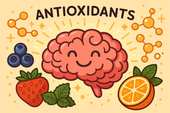
How Antioxidants Protect Emotional Well-being: The Hidden Link Between Oxidative Stress and Mental Health
Antioxidants do more than protect your body — they defend your mind. By neutralizing oxidative stress, antioxidants support serotonin, dopamine, and brain energy pathways that keep you calm, focused, and emotionally balanced. Discover how foods like berries, green tea, and dark chocolate nourish your brain, boost mood, and strengthen resilience from the inside out. 🌿✨
-
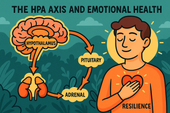
The HPA Axis and Emotional Health: The Hidden Bridge Between Stress and Mind
Neuroplasticity — the brain’s ability to rewire and adapt — is the foundation of emotional healing and resilience. When you face stress, trauma, or change, your neural pathways can reshape themselves to support new patterns of calm, focus, and self-awareness. Learn how daily practices like mindfulness, therapy, and breathwork strengthen neuroplasticity to transform emotional pain into personal growth. 🌸
-

Why Cortisol Control Is Key to Resilience: Mastering Stress to Build Emotional Strength
Controlling cortisol — the body’s main stress hormone — is the secret to lasting resilience. When cortisol levels stay balanced, your mind becomes clearer, emotions steadier, and energy more sustainable. Learn how breathwork, mindset shifts, adaptogens, and daily rhythms can help you calm your stress response and build true inner strength. 🌞💪
-
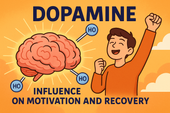
Dopamine’s Influence on Motivation and Recovery: Reigniting Drive and Balance
Healthy relationships are the foundation of emotional balance and resilience. Whether romantic, familial, or platonic, genuine connection releases dopamine, serotonin, and oxytocin — the brain’s “bonding trio” — helping us feel secure, motivated, and seen. Learn how trust, empathy, and communication not only strengthen your connections but also reshape your nervous system for deeper emotional well-being. 🌿🤝
-
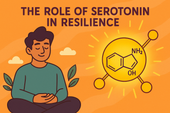
The Role of Serotonin in Resilience: How This “Mood Molecule” Shapes Emotional Strength
Serotonin — often called the “resilience molecule” — plays a vital role in how we handle stress, regulate mood, and recover from emotional challenges. Beyond happiness, this powerful neurotransmitter helps balance the gut-brain axis, stabilize the nervous system, and support emotional flexibility. Learn how nutrition, sunlight, mindfulness, and adaptogens can naturally boost serotonin and strengthen your emotional resilience. 🌞🧠
-

How Neuroplasticity Supports Emotional Growth: Rewiring the Brain for Resilience
Neuroplasticity is the brain’s built-in power to grow, adapt, and heal — and it’s the foundation of emotional transformation. Every mindful breath, compassionate act, or reframed thought strengthens new neural pathways that support resilience and self-awareness. Learn how your brain rewires through daily habits, helping you turn emotional challenges into opportunities for growth and calm. 🌿
-

Tai Chi and Adaptogens for Mind-Body Balance: The Art of Harmonizing Energy and Resilience
Alchemy isn’t just an ancient science — it’s a timeless symbol of transformation and inner balance. By blending the physical and spiritual, alchemy teaches us that change begins from within. Just as metals are refined into gold, we too can transmute emotional pain, stress, and chaos into clarity and strength through mindful practice and self-awareness. 🌙✨
-

Cold Therapy and Emotional Control: Training the Mind Through the Body
Cold therapy isn’t just for athletes — it’s a tool for emotional mastery. By exposing your body to controlled cold, you train your nervous system to stay calm under stress, improving focus, mood, and resilience. This article explores the science of cold exposure, its impact on hormones and the vagus nerve, and how ice baths and cold showers can help you build emotional control, one breath at a time. 🧊🧘♂️
-

How Music Influences Emotional Recovery: The Healing Soundtrack of the Mind
Neuroplasticity — the brain’s ability to rewire and heal itself — is at the heart of emotional recovery. Through mindful habits, music, therapy, and consistent mental stimulation, your brain can form new connections that support resilience and well-being. Discover how neuroplasticity turns pain into growth, helping you rebuild balance, focus, and emotional strength. 🌿
-

Nature Therapy for Building Resilience: Reconnecting With the Healing Power of the Earth
Nature therapy helps rebuild emotional resilience by reconnecting you with the healing rhythms of the Earth. From forest walks to sunlight exposure, nature restores balance to your nervous system, lowers stress hormones, and teaches emotional adaptability. Learn how spending time outdoors can enhance mental clarity, calm anxiety, and awaken your natural capacity to heal. 🌞
-

Breathwork Techniques That Pair with Supplements: The Ultimate Synergy for Stress Relief and Mental Clarity
Breathwork and supplements create a powerful mind-body synergy for stress relief, focus, and energy. By combining intentional breathing with adaptogens, nootropics, and calming nutrients, you can naturally regulate cortisol, sharpen mental clarity, and boost emotional balance. This guide explores the best breathwork techniques and supplement pairings to help you feel centered, calm, and energized from the inside out. 🌿
-
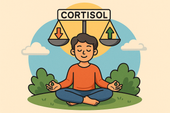
Why Cortisol Balance Matters for Emotional Strength
Balancing cortisol — your body’s main stress hormone — is essential for emotional resilience. When cortisol is chronically high, your mind stays stuck in survival mode, leading to fatigue, anxiety, and emotional instability. This article explores how nutrition, supplements, breathwork, and therapy can help restore healthy cortisol rhythms, regulate the nervous system, and strengthen your ability to handle life’s challenges with calm focus and emotional strength. 🌿
-

Best Supplements for Students During Exam Season: Focus, Energy, and Memory Support
Studying late into the night? Learn which natural supplements can boost focus, memory, and mental stamina during exam season — without the crash. From omega-3s to Bacopa and Rhodiola, discover your brain’s ultimate exam support stack. 🎓🧠
-

Natural Memory Boosters for Seniors: How to Keep Your Mind Sharp and Focused
Stay mentally sharp and confident as you age. Discover science-backed natural supplements and lifestyle habits that boost memory, focus, and brain longevity for seniors. 🌿🧠
-
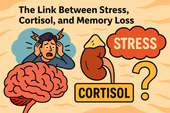
The Link Between Stress, Cortisol, and Memory Loss
Chronic stress can quietly erode your memory — and cortisol is the key culprit. Learn how stress hormones affect the brain, why the hippocampus shrinks under pressure, and how natural strategies can help you restore memory and mental clarity. 🧠✨
-

How to Build a Daily Supplement Routine for Memory Health
Want to sharpen your memory and stay mentally clear? Learn how to build a daily supplement routine for memory health — from morning focus to nighttime brain repair. Discover science-backed nutrients that boost recall, focus, and long-term cognitive resilience. 🧠🌿
-
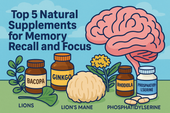
Top 5 Natural Supplements for Memory Recall and Focus
Looking to boost memory and concentration naturally? Discover the top 5 supplements — Bacopa, Ginkgo Biloba, Lion’s Mane, Rhodiola, and Phosphatidylserine — that enhance focus, recall, and long-term brain health. 🧠✨
-

Top Supplements to Balance Mood Naturally
From omega-3s to adaptogens, discover the top natural supplements proven to support emotional balance, reduce stress, and promote inner calm — safely and effectively. 🌿✨
-

Can Omega-3 Fatty Acids Help with Mood Disorders?
Omega-3 fatty acids do more than support heart health — they can help balance mood, reduce depression, and calm anxiety. Discover how EPA and DHA nourish your brain, fight inflammation, and support emotional well-being from within. 🌊🧠
-

Vitamin D and Mood: The Sunshine Vitamin for Emotional Balance
Could the key to emotional balance be as simple as a little sunlight? Discover how vitamin D — the sunshine vitamin — influences serotonin, reduces inflammation, and helps you feel more positive and resilient year-round. ☀️💛
-

The Role of Magnesium in Reducing Irritability and Low Mood
Feeling on edge or emotionally drained? Magnesium could be the missing link between your body and your mood. Discover how this essential mineral reduces irritability, balances neurotransmitters, and helps your nervous system find calm again. 🌿✨
-
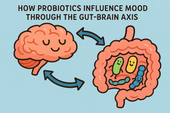
How Probiotics Influence Mood Through the Gut-Brain Axis
Discover how probiotics can do more than support your digestion—they can actually uplift your mood. This article explores the fascinating gut-brain axis and how balancing your gut bacteria through probiotics may help reduce anxiety, improve emotional stability, and support long-term mental well-being. 🌿🧠
-

Ashwagandha for Stress and Mood Regulation
Discover how Ashwagandha, the powerful adaptogenic herb 🌿, helps your body manage stress and regulate mood. Learn how it balances cortisol, boosts GABA and serotonin, and supports emotional stability — helping you feel calm, focused, and resilient every day.
-

St. John’s Wort: Natural Support for Mild to Moderate Depression
Discover how St. John’s Wort, the “sunshine herb” 🌼, naturally supports mild to moderate depression. Learn how it boosts serotonin, balances mood, and promotes emotional resilience — with research showing its effectiveness compares to antidepressants, but with fewer side effects.
-
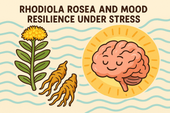
Rhodiola Rosea and Mood Resilience Under Stress
Discover how Rhodiola rosea helps your body adapt to stress 🌿. Learn how this powerful adaptogen balances cortisol, supports serotonin and dopamine, and strengthens emotional resilience — helping you stay calm, focused, and energized under pressure.
-

Chamomile and Lavender: Herbal Calm for Emotional Fluctuations
Discover how chamomile and lavender bring calm to emotional ups and downs 🌿. Learn how these two soothing herbs balance your nervous system, ease anxiety, and support restful sleep — naturally helping you find peace and emotional stability.
-
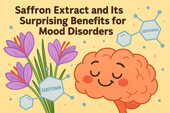
Saffron Extract and Its Surprising Benefits for Mood Disorders
Discover how saffron extract — the golden spice of joy 🌸 — can naturally support mood balance, ease anxiety, and lift mild depression. Learn what science says about its serotonin-boosting power, the ideal dosage, and how this ancient remedy compares to modern antidepressants.
-
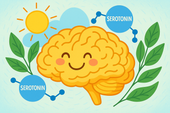
5-HTP and Serotonin: A Natural Path to Lifting Mood
Discover how 5-HTP naturally boosts serotonin 🌞 — the neurotransmitter behind mood, sleep, and emotional balance. Learn how this plant-derived compound supports happiness, reduces anxiety, and improves rest by helping your brain create more serotonin the gentle, natural way.
-

GABA Supplements for Reducing Anxiety and Mood Swings
Discover how GABA supplements can help reduce anxiety and balance mood naturally 🌿. Learn how this calming neurotransmitter works to quiet the mind, ease stress, and improve sleep — plus which nutrients and habits can boost your body’s own GABA production for long-term emotional stability.
-
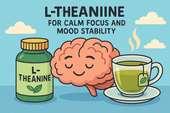
L-Theanine for Calm Focus and Mood Stability
Discover how L-theanine, the calming compound found in green tea 🍵, promotes focus, relaxation, and mood stability. Learn the science behind how it balances neurotransmitters, reduces stress hormones, and enhances clarity — helping you stay centered, calm, and productive without sedation.
-
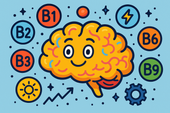
B Vitamins and Brain Chemistry: Supporting Energy and Emotional Balance
Discover how B vitamins power your brain chemistry ⚡. Learn how B6, B9, and B12 support serotonin, dopamine, and energy production — helping boost focus, mood, and emotional balance. From diet to supplements, explore how this vital nutrient group keeps your mind resilient and your energy steady.
-

N-Acetyl Cysteine (NAC) and Mood Disorders: What the Research Says
Learn how N-Acetyl Cysteine (NAC) supports brain health and mood balance 🧠. Discover how this antioxidant helps reduce oxidative stress, regulate glutamate, and improve emotional stability in depression, bipolar disorder, and anxiety — backed by cutting-edge psychiatric research.
-

Supplements for Bipolar Disorder: What May Support Stability
Discover the best supplements for bipolar disorder 🌿 that may support emotional stability and brain health. Learn how nutrients like omega-3s, magnesium, vitamin D, and NAC can help reduce inflammation, balance neurotransmitters, and complement traditional treatment safely.

















































